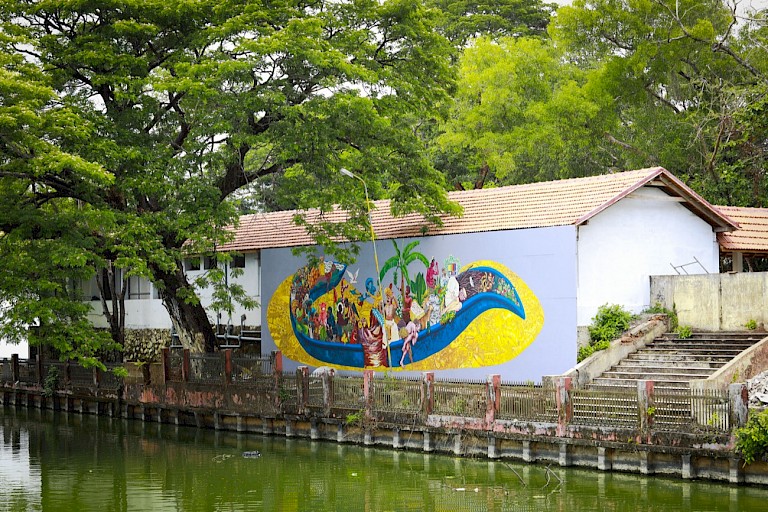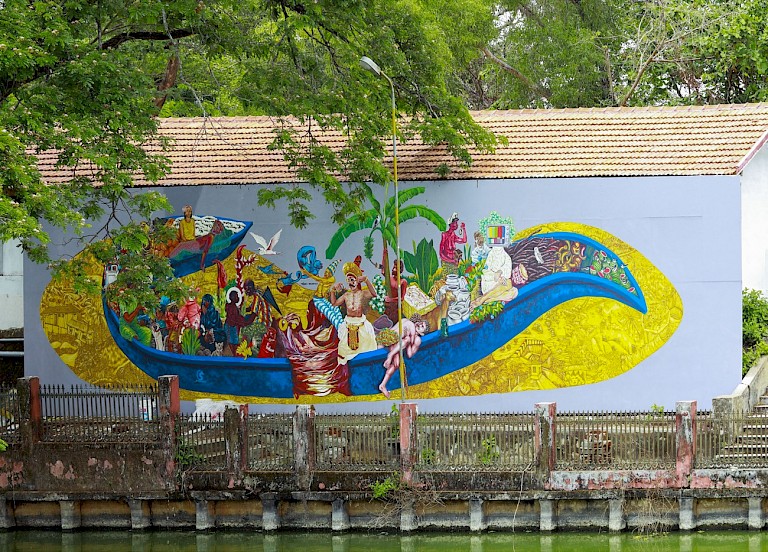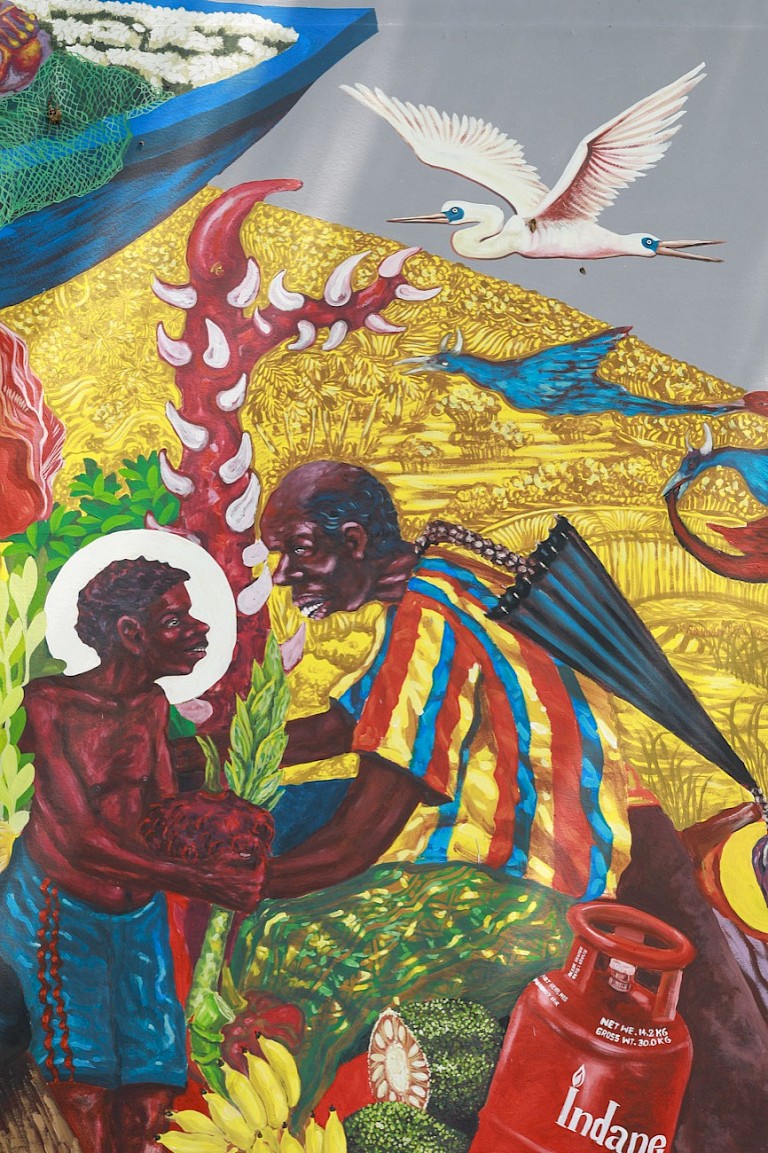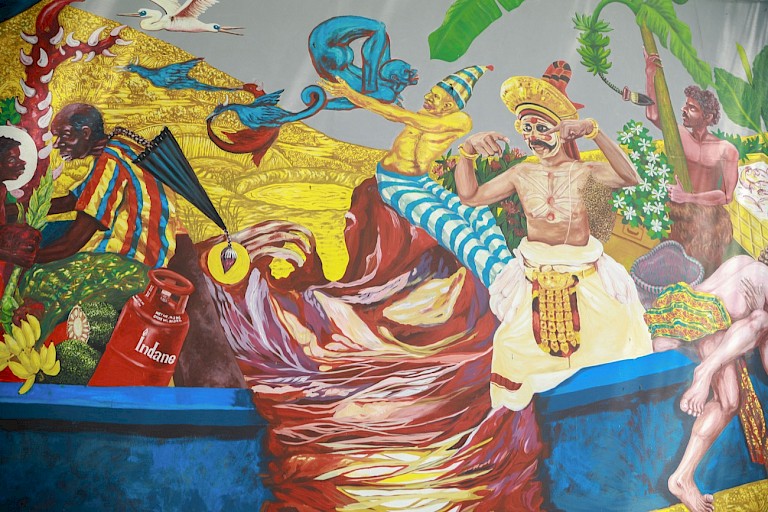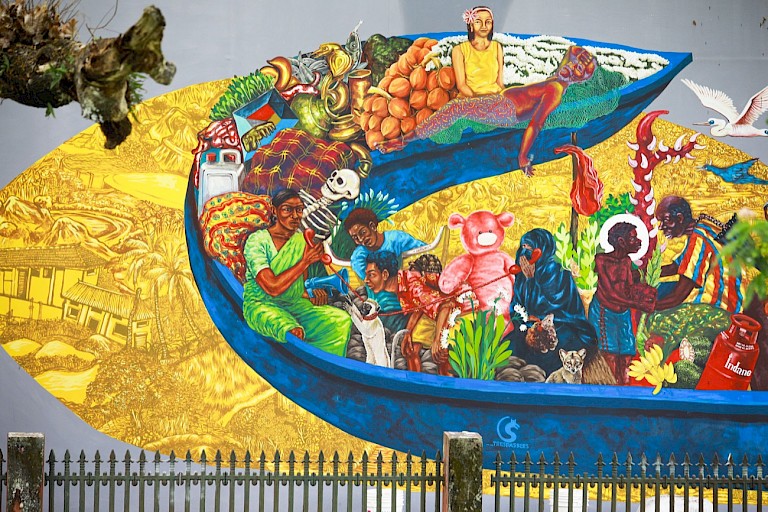



The Artists
Trespassers, an assembly of eight artists from Kalady, Kerala, are a dynamic force in the realms of murals, short films, and videos. United by a profound vision, they redefine artistic narratives in their region. With members like Pranav, Vishnupriyan K, Jinil Manikandan, Amit Payannur, Bashar UK, Sreerag Kannan, Arun Gopi, and Ambadi Kannan, Trespassers draw strength from the artistic community of Sree Sankaracharya University of Sanskrit. This shared vision breathes life into public spaces in Kalady.
Armed with brushes, Trespassers infuse vitality into Kalady's markets, bus stands, hospitals, and more, narrating unique stories that interweave the tapestry of their region's history and culture. What sets them apart is their deliberate choice to be identified solely as a collective, eschewing individual recognition.
Trespassers focuses on the connection between their art and the viewer, seeking to make art accessible beyond conventional gallery spaces, reaching those who might otherwise be excluded.
Their unwavering commitment and dedication have reshaped Kalady's landscape, sparking cultural dialogue within the community. Their murals serve as both visual feasts and poignant reflections of their region's narratives.
Trespassers stand as a testament to the transformative power of collective creativity. They invite viewers to engage with their surroundings in a deeper, more meaningful way, bridging the gap between artistic expression and everyday life.
Conceptual Genesis:
The inception of Endless Gathering was rooted in the artists' commitment to create a shared space of expression, with each artist retaining their unique voice. Rather than relying on a pre-determined blueprint, the Collective's approach was more organic, drawing inspiration from the lives, habitats, and narratives of the regional populace. The profound influences were the region's history combined with the pressing contemporary challenges, notably the dual tragedies of floods and the health crises of Nipa h and COVID. These events not only set the tone but also deeply influenced the narrative arc of the artwork.
Audience-Centric Development:
A distinctive feature of the artwork's evolution was its treatment of public art as a continual performance. This approach deviated from traditional artistic presentations. Instead of a passive audience witnessing the culmination, the public were integral from the outset. Their constant feedback, be it in criticisms, commendations, or casual comments, actively shaped the artwork's visual trajectory. This transformed the entire development process into a rich dialogue, binding artists, viewers, and the space into a cohesive narrative. Such continual engagement ensured the artwork's deep resonance with the community, making it a living testament to their shared experiences and aspirations.
Artistic Symbolism:
Amidst the unfolding narrative was the poignant symbolism of the boat. This element, central to the artwork, was a reflection of the times – an era marked by uncertainties and transitional spaces. The 'U' shaped curvature of the boat was dually representative of motion and inertia. While drawing inspiration from the biblical tale of Noah’s Ark, the boat also housed diverse stories. The artists sought to imbue the boat with life, veering away from a mere mechanical representation. This was evident in the inclusion of characters like Kunjaalan Devaki, a regional transperson, and others marginalised or grappling with identity crises. Each character added layers to the story, emphasising inclusion, resilience, and diversity.
Physical Execution:
The on-ground execution was intense and immersive. Spanning four days, from March 24 to 27, 2021, the artists translated their shared vision into reality. The backdrop of the canal played an unforeseen yet influential role in shaping the artwork's composition. As the artists worked, distant spectators across the canal voiced their observations, leading to spontaneous adjustments in elements such as size, shape, and colour application. This dynamic, responsive approach further underscored the Collective's commitment to community engagement and adaptability.
A Continual Performance:
One of the standout features of Endless Gathering is the active incorporation of its audience throughout the artwork's development process. Defying the traditional norms of artistic creation, where the audience merely witnesses the finished product, this project treated public art as a living performance. This interaction made the audience stakeholders, not just spectators. Their myriad responses — criticisms, jokes, comments, and observations — did not merely pass as fleeting reactions; they actively shaped the artwork's trajectory. Such a unique approach ensured that the art didn't just speak to the community but also echoed their voices.
The Canal as the Conduit:
The presence of the canal near the artwork served as a unique stage, intensifying audience engagement. Distant spectators from across the canal often shared their observations, sometimes even shouting their responses. This real-time feedback led to on-the-spot artistic adjustments, underscoring the artwork's dynamic nature and the artists' adaptability. The reflection of the artwork in the canal waters further magnified its impact, leading to reflections in both literal and metaphorical senses.
Symbolic Resonance:
Central to Endless Gathering is the evocative symbol of the boat. Given the region's recent history, marked by floods and pandemics, the boat symbolised a sanctuary and a vessel of collective hopes. The artwork's duality of representing both mobility and inertia struck a chord with many, mirroring their experiences of turmoil and stasis. The inclusion of diverse characters in the boat narrative, from marginalised individuals to those grappling with identity crises, emphasised inclusivity. This representative approach ensured that diverse audience segments could see their stories, fears, and aspirations mirrored in the artwork.
In an age marked by social distancing due to the COVID pandemic, the artwork became a nexus for communal engagement, albeit from a distance. The audience's unique mode of interaction — from afar yet intimately involved — added depth to the project. It transformed public spaces into arenas of shared narratives and collective catharsis, emphasising the importance of community in challenging times.
Varied Responses:
The reactions to Endless Gathering were as diverse as its audience. Many found solace, seeing their experiences reflected in the artwork. Some found it a platform to voice their concerns, fears, and hopes. The presence of characters like the Chaakyaar, a symbol of social critique, resonated with those seeking introspection and change. However, the artwork also evoked a spectrum of responses. From admiration to critique, from profound reflections to casual observations, every reaction enriched the narrative of Endless Gathering.
In conclusion, Endless Gathering wasn't merely a visual spectacle; it was a dynamic conversation. It blurred the lines between artists, artwork, and audience, fostering a sense of communal belonging. Through its unique approach and profound symbolism, it not only reflected the socio-cultural milieu but also shaped it, leaving an indelible mark on its audience.
